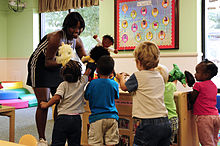Çerdhe fëmijësh
Çerdhe fëmijësh është një institucion arsimor i cili merret me përkujdesin dhe mbikëqyrjen për rritjen dhe edukimin e fëmijëve të periudhës parashkollore, zakonisht deri në moshën tre vjeçare. Kujdesi për fëmijët është veprim ose aktivitet i cili mund të kryhet nga një qendër e kujdesit ditor, dado, kujdestare, edukatore, mësuese, etj.

Përmbledhje
RedaktoKujdesi për fëmijët është një temë komplekse që përfshin një spektër të gjerë të profesionistëve, institucioneve, konteksteve, aktiviteteve dhe konventave sociale dhe kulturore. Kujdesi ndaj fëmijëve në periudhën e fëmijërisë së hershme parashkollore është një komponent po aq e rëndësishme, shpesh e anashkaluar e zhvillimit të fëmijëve. Ofruesit e kujdesit për fëmijë mund të jenë mësuesit e parë të fëmijëve, dhe për këtë arsye ata mund të luajnë një rol integral në sistemet e edukimit dhe arsimimit të hershëm të fëmijëve. Kujdesi cilësor në një moshë të re mund të ketë një ndikim thelbësor në sukseset e mëvonshme të fëmijëve. Fokusi kryesor i kujdesit për fëmijët në këto institucione është në zhvillimin e fëmijës, qoftë ai mendor, social ose psikologjik. [1]
Në shumicën e rasteve, për fëmijët kujdesen prindërit e tyre, kujdestarët ligjorë ose motrat dhe/apo të afërmit. Në disa raste, gjithashtu shihet se për fëmijët kujdesen fëmijët e tjerë. Kjo përkujdesje informale përfshin drejtimin verbal, ushtrime dhe trajnime të tjera të qarta në lidhje me sjelljen e fëmijës, dhe shpesh është po aq e thjeshtë sa edhe "mbajtja e vëmendjes" për motrat dhe vëllezërit më të vegjël. [2] Kujdesi ndaj fëmijëve nga fëmijët e moshave të ngjashme mbulon një sërë efektesh zhvillimore dhe psikologjike. [3] Një rol të kujdesit ndaj fëmijëve të kësaj periudhe mund ta marrë edhe familja e zgjeruar e fëmijës. Një formë tjetër e kujdesit për fëmijë i cili është në fazën e rritjes dhe zhvillimit krahas me përkujdesjen familjare është ajo e kujdesit për fëmijë në qendër profesionale. Në vend të kujdesit familjar, këto përgjegjësi mund t'u jepen kujdestarëve të paguar, jetimoreve ose shtëpive kujdestare me qëllim të sigurimit të kujdesit, strehimit dhe shkollimit. [4]
Shih edhe
RedaktoLiteratura
Redakto- Buysee, V.; P. W. Wesley (2005). Consultation in Early Childhood Settings (në anglisht). Baltimore: Paul H. Brookes Publishing. ISBN 978-1-55766-774-8.
- Center for Public Education. (March 2007). Retrieved 2 July 2009, from http://www.centerforpubliceducation.org/Main-Menu/Pre-kindergarten/Pre-Kindergarten/Pre-kindergarten-What-the-research-shows.html Arkivuar 3 korrik 2013 tek Archive.today
- Condillac, E. B. (1746/1970, 2001). Essai sur l'origine des connaissances [Essay on the origin of human knowledge] in Oeuvres Completes Tome 1. Genève: Slatkine reprints. Retrieved from http://www.slatkine.com/. In addition, translated from the French of the Abbé de Condillac by Hans Aarsleff, Cambridge, MA: Cambridge University Press.
- Condillac, E. B. (1749/1970, 1982). Traité des systèmes [Treatise on the systems] in Oeuvres Completes Tome 2. Genève: Slatkine reprints. Retrieved from http://www.slatkine.com/. In addition, translated from the French of the Abbé de Condillac by Franklin Philip, Philosophical Writings of Etienne Bonnot, Abbé de Condillac (Vol. I), Hillsdale, NJ: Lawrence Erlbaum.
- Condillac, E. B. (1754/1982). Traité des sensations [Treatise on the sensations]. Genève: Slatkine reprints. Retrieved from http://www.slatkine.com/. In addition, translated from the French of the Abbé de Condillac by Franklin Philip, Philosophical Writings of Etienne Bonnot, Abbé de Condillac, and (Vol. I), Hillsdale, NJ: Lawrence Erlbaum.
- Condillac, E. B. (1756). An essay on the origin of human knowledge. In Locke's Essay on the Human Understanding. Translated from the French of the Abbé de Condillac by Thomas Nugent. London, England: J. Nourse. Retrieved 23 September 2008 from https://books.google.com/books?id=rp_go5DhQqQC .
- Fay, J. & Funk, D. (1995). Teaching with love & logic. Golden, CO: The Love & Logic Press, Inc.
- Glasser, W. (1984). Self-importance boosts learning. The School Administrator 45, 16–18.
- Glasser, W. (1996). "Then and now. The theory of choice". Learning (në anglisht). 25 (3): 20–22. Marrë më 30 shtator 2013.
- Heyman, G., Dweck, C., & Cain, K. (1992). Young children's vulnerability to self-blame and helplessness: Relationship to beliefs about goodness. Child Development, 63, 401–415.
- Individuals with Disabilities Individualizing Education Act (IDEA) Data. (2006). Part B child count data [Table]. Retrieved 25 May 2008, from https://web.archive.org/web/20130727110604/http://www.ideadata.org/PartBData.asp
- Itard, J. M. G. (1962). The wild boy of Aveyron. (G. Humphrey & M. Humphrey, Trans.). New York: Appleton-Century-Crofts. (Original works published 1801 and 1806).
- Levin, H. M.; Schwartz, H. L. (2007b). "Educational vouchers for universal pre-schools" (PDF). Economics of Education Review (në anglisht). 26: 3–16. CiteSeerX 10.1.1.503.4256. doi:10.1016/j.econedurev.2005.10.006. Arkivuar nga origjinali (PDF) më 4 nëntor 2012.
- Levin, H.M.; Schwartz, H.L. (2007). "What is the cost of a preschool program?". Symposium conducted at the meeting of the AEFA Annual Conference (në anglisht). National Center for the study of Privatization in Education., Baltimore, Maryland.
- McCollum, J. A.; Yates, T. (1994). "Dyad as focus, triad as means: A family-centered approach to supporting parent-child interactions". Infants and Young Children (në anglisht). 6 (4): 54–63. doi:10.1097/00001163-199404000-00008.
- Reeves, K. (2000). Preschool in the public schools (në anglisht). American Association of School Administrators. 1-9
- Skinner, B. F. (1954). "The science of learning and the art of teaching". Harvard Educational Review (në anglisht). 24 (2): 86–87.
Referime
Redakto- ^ Caring for Our Children: National Health and Safety Performance Standards: Guidelines for Early Care and Education Programs (në anglisht). Elk Grove Village: American Academy of Pediatrics. 2011. fq. 79.
- ^ [Weisner, Thomas S., et al. “My Brother's Keeper: Child and Sibling Caretaking [and Comments and Reply].” Current Anthropology, vol. 18, no. 2, 1977, pp. 169–190., doi:10.1086/201883.]
- ^ National Health and Safety Performance Standards: Guidelines for Early Care and Education Programs (në anglisht). Elk Grove Village: American Academy of Pediatrics. 2011. fq. 79.
- ^ ChildForum Childcare Information http://www.childforum.com/options-a-differences-between-ece-programmes/73-private-childcare-arrangements-making-your-own-and-what-is-involved.html